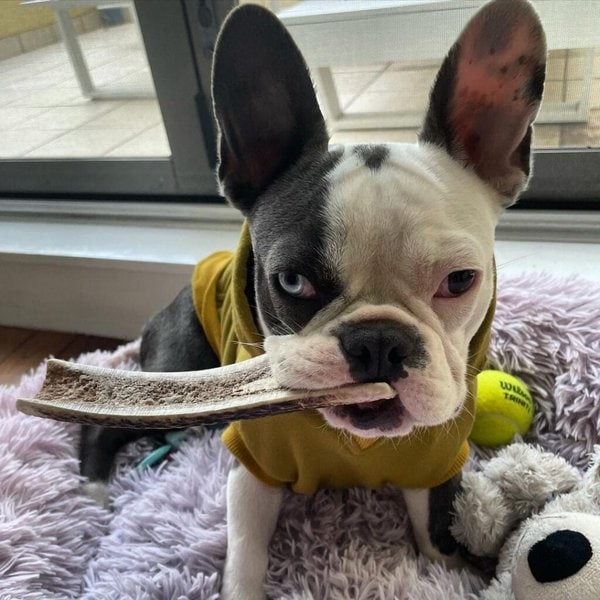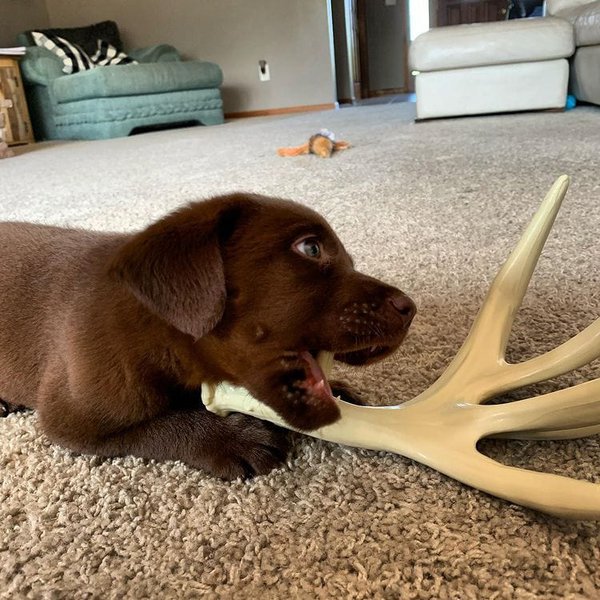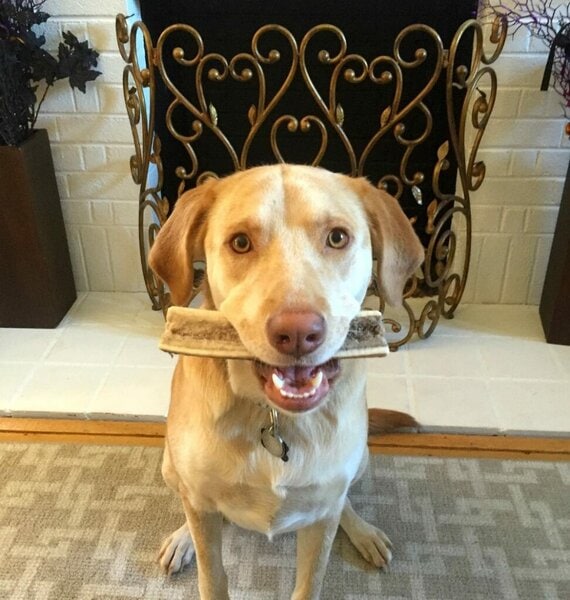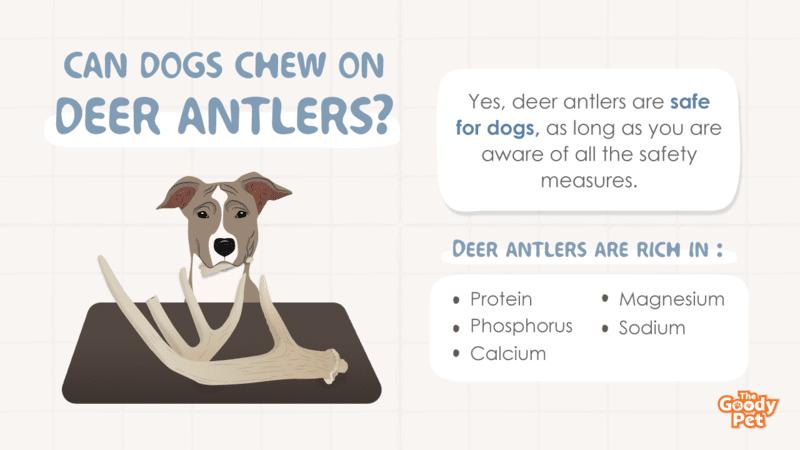Deer antlers are bony structures that are shed annually by male deers. These antlers are used as dog chews not only because they are long-lasting chews, but also because they are favored by dogs who are attracted to their natural smell and taste.
Deer antlers are safe for dogs to chew on, as long as you give these dog chews properly. For example, be sure to get a deer antler that is large enough for your dog, lest you risk it from getting choked if the size is not right.
However, chewing on deer antlers does not come without controversy. What started out as natural chews for dogs has been drawing criticism recently from groups that do not espouse the use of deer antlers, citing reasons such as teeth damage and bone splinters posing as choking hazards.
Today, we’d talk more about the benefits as well as the safety precautions so your dog can enjoy deer antler chews. At what age should you begin to give deer antlers to your dog? Do you need to boil these? Let us now learn more about deer antlers.
Are Deer Antlers OK For Dogs?
Yes, deer antlers are safe for dogs to chew on, as long as you are aware of all the safety measures.
Regardless of age, dogs are always looking for something hard to chew on. Look at it as their way of taking care of their teeth. The grinding and gnawing of dog chews like antlers can lessen tartar off their teeth and make their gums healthier.
Not to forget that their wild ancestors crushed bones with their teeth to gnaw their way to the marrow or the center of the bone which contains high levels of protein and other essential nutrients. It’s no wonder that domesticated dogs such as yours continue to yearn for that bone to chew on.
Why should you give deer antlers to your dog? Are these long-lasting? Let’s find the answers.

Deer Antlers Are Nutritious
If there’s one thing you’d love about antlers, it is the fact that they are devoid of artificial flavors and preservatives. Your dog will love deer antlers because of the delicious taste of dried marrows found inside them.
Not only are these flavor-packed, but deer antlers are rich in protein, phosphorus, calcium, magnesium, sodium, and other essential minerals.
Though deer antlers are okay for dogs, too much of anything is bad. Deer antlers, because of their high protein content, are no exception. Allow your dog to indulge in about half an inch of antler a day to prevent stomach discomfort.
Deer Antlers Last Long
There’s nothing worse than giving your dog some expensive dog chews and only to see these broken into pieces in just a matter of time. Natural dog chews like deer antlers are long-lasting, greaseless, and odor-free.
Most of the quality antlers on the market will last up to 6 months to more than a year.
Deer Antlers Are Hypoallergenic
As a novel protein not commonly used in dog food and treats, deer antlers will not cause adverse reactions to those dogs with sensitive stomachs.
In fact, venison or deer meat is the recommended protein source for dogs that are going on an elimination diet. This is because venison meat is known to lessen inflammation and allergic reactions.
The other reason why deer antlers are okay for your fur baby is that these are calorie-free, thus, there is no risk for obesity. Plus, deer antlers are good for your dog’s oral health and will certainly last a lot longer than dental chews.
You may now ask, “since not all dogs have the same chewing strengths, do deer antlers come in varying toughness levels?” Yes, they do. So before getting one for your fur baby, you may want to consider which is the appropriate one to buy:
- Moose antlers are the softest and have a higher marrow content. These are perfect for gentle nibbler dogs.
- Elk antlers are the best choice for older dogs that have sensitive teeth.
- Split elk antlers are divided in the middle to expose the marrow. This is the one recommended for puppies and senior dogs.
- Whitetail deer antlers are the hardest, thus, these are suitable if your dog is an aggressive chewer.
Are Deer Antlers Safe For Puppies? At What Age Can Puppies Chew On Deer Antlers?
Puppies as young as 12 weeks of age can be allowed to chew on deer antlers. But, they have to be supervised to prevent them from getting choked and be faced with other health problems.
Deer antlers can assist in the discomfort that comes with the teething process. But, again, allow us to emphasize that you do this with extreme caution as puppies are more vulnerable in swallowing objects.
That said, what you want to look for is an antler that is big enough to avoid choking yet small enough so your puppy can chew the deer antler effectively.
In this section, we’d teach you how you can give antlers to puppies the safest way possible. We’d also touch on the issue of why split antlers are recommended for teething puppies.
How To Safely Give Deer Antlers To Puppies?
At around the 12th week of age, the adult teeth of puppies start to come out, so their chewing abilities become much better. Not to forget that their teeth are also stronger around this time.
However, as mentioned earlier, there are always two sides to a coin when it comes to the decision of giving deer antlers. There’s no question that puppies can benefit from the nutritional values of antlers. Plus, these can also serve as a recreational activity for them.
On the flip side, deer antlers may also present some dangers such as fractured teeth and intestinal obstruction.
To be on the safe side, once the deer antlers have become brittle, take them away from your puppy as this can splinter into small pieces and cause choking.

How To Soften Deer Antlers?
Softening the deer antler is one way to make it safer for your fur baby.
If you think that the deer antler is too hard to chew on, what you can do is to soak it in plain water or in broth for 24 to 48 hours. Doing so softens and makes it easier and safer for puppies to chew on.
Also, softening the deer antler will prevent puppies from fracturing their teeth and their gums from bleeding. What about split antlers, are these better for teething puppies?
Split VS Whole Antlers, What’s The Difference?
Split antlers are whole antlers that are sliced in the middle so the marrow is exposed.
For puppies, we suggest the split antlers because they do not have to gnaw on the deer antler too much to reach the much-coveted marrow. This is an awesome way for puppies to familiarize themselves with antlers and enjoy these special treats.
The only problem with the splits is that these do not last longer compared to whole antlers. This is because the split antlers no longer have the durable calcium exterior that makes it long-lasting.
Can Dogs Get Sick From Deer Antlers?
It is possible that your dog can get sick from deer antlers, especially if you fail to supervise your fur baby.
As we said earlier, there are two sides to a coin and this is because deer antlers can damage dogs’ teeth, can cause choking, and intestinal blockage.
Broken Teeth
Canine tooth fractures from chewing on deer antlers are real and can cause pain and discomfort. In dogs, the most common tooth fracture occurs on their fourth premolar, also referred to as carnassial tooth.
Chewing or biting onto something very hard like deer antlers is the major cause of tooth fracture on the carnassial tooth. This problem can possibly exacerbate into something more serious which is the development of tooth abscesses.
Choking Hazard
Anything that can be broken down into small pieces, like deer antlers, may cause esophageal obstruction. This is a life-threatening condition because dogs can’t get enough oxygen into their system.
Some of the common signs of esophageal obstruction are:
- Excessive drooling
- Difficulty in swallowing
- Regurgitating
- Gagging

Intestinal Blockage
In cases where dogs swallow a big portion of deer antlers, these objects can get stuck in their digestive system. Though there are some debates among veterinarians on whether stomach acid can break down the deer antlers, it is still possible for some food to get stuck along the intestines due to a blockage caused by an undigested antler.
In severe cases, intestinal obstruction may cause a part of the intestines to be severely damaged. Dogs with this condition may get very sick and may even die from it.
The signs of an intestinal blockage are:
- Abdominal pain
- Vomiting
- Lethargy
- Loss of appetite
To prevent these health problems, kindly read the tips below so your dog can be safe and happy while chewing on deer antlers.
Tips On How To Safely Give Deer Antlers
- Make sure that the deer antler is large enough to avoid choking.
- Look for sharp edges, and if you see any, you can soften these edges by rubbing them against sandpaper.
- Make sure that your dog is gnawing and not breaking the deer antler in half. If your dog is bearing down hard on it, remove the deer antler to avoid fracturing its teeth.
- Remember to allow your dog to chew only ½ inch of antler a day.
- If the deer antler gets worn down to a small size, remove it to prevent your dog from getting choked.
- If you happen to see deer antlers in the woods, do not give these to your dog. It’s because you have no idea about the age of those antlers. The ones you buy in the store are made from fresh deer antlers, free from bacterial contaminations.





